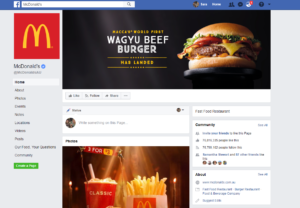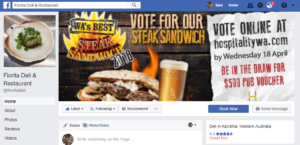Abstract
This paper examines social networking service, Facebook, and the way in which it provides businesses with intrusive access to potential consumers through paid advertising. It examines how Facebook collects data from a platform user and allows businesses to conduct paid marketing campaigns that use this information to target specific audiences. It looks at how effective this approach is in comparison to more traditional forms of consumer engagement and also discusses the issues associated with the collection of user data, of most relevance the Cambridge Analytica scandal.
Keywords: Social media networks, Facebook, online communities, consumer engagement, online marketing, user segmentation, Cambridge Analytica
Introduction
Online social networking platforms have created new ways for people to communicate with each other, ways which are now exceedingly popular (Arnaboldi, Conti, Passarella & Dunbar, 2017). Facebook is the most visited of these online networking platforms with more than 600 million users worldwide (Ramsaran-Fowdar & Fowdar, 2013).
Its use is habitual, with the majority of users logging on multiples times per day to post photos, videos and text updates for followers, receive similar updates from friends, and view entertainment sources and Facebook pages they follow. Social media platforms have become a ritualised part of users daily lives, often visited before getting out of bed in the morning and before falling asleep again at night time (Alhabash & Mengyan, 2017; boyd & Ellison, 2007). Building on this ingrained use of the platform within its user community, Facebook has created an online engagement approach that allows businesses intrusive access to consumers through data collection and user segmentation.
I begin this paper by discussing the way businesses are included on the social networking platform. Then I examine the consumer engagement opportunities Facebook offers business and how these compare to offline alternatives. Finally, I look at the risk associated with the collection of user-data to provide those consumer engagement opportunities, namely the recent Cambridge Analytica scandal.
For the purpose of this paper, online engagement is defined as the encouragement of consumers to interact with a business or organisation over the internet. Engagement with a business on Facebook is positively linked to business reputation and public perception (Djikmans, Kerkhof & Beukeboom, 2015).
Literature Review
While social media and online platforms are relatively new concepts, scholars have quickly begun to analyse the effects of these communication tools on users as well as the implications for business. Ramsaran-Fowdar and Fowdar (2013) see Facebook as marketing tool far superior to those based offline and this sentiment is echoed by Threatt (2009). As mentioned in my introduction, both Alhabash and Mengyan (2017) and boyd and Ellison (2207) have discussed in their work the daily use of Facebook by its community and this is a major component in the success of consumer engagement through the platform. It is widely accepted among authors that social media platforms, particularly Facebook, are exceptional tools for business and credit this new era of transformative communication with the creation of niche markets that are able to be so effectively targeted (Ramsaran-Fowdar & Fowdar, 2013; Wellman & Guilia, 1997).
This area becomes all the more interesting with the recent Cambridge Analytica scandal and the effects this will have across social media platforms moving forward. This has been an investigation picked up by media outlets world-wide such as The Guardian, Sydney Morning Herald, New York Times and Washington Post, and examines the privacy of the information users share on Facebook and the security of this data when collected by the platform and third-party applications.
Through the work of these authors and the support of many others I argue my thesis; that Facebook has created an online engagement approach that allows businesses intrusive access to consumers through data collection and user segmentation.
Discussion
Conceived in February 2004, Facebook originally focused on creating personal relationship (Thompson, 2008). It wasn’t until November 2007 that the platform made a move into the provision of paid engagement opportunities for organisations (Threatt, 2009 & Bellis, 2018). As more of the worlds population join in the online social networking craze, communication using these platforms is now widely accepted and often one of the first places consumers will try and seek out information, on both people and businesses (Ramsaran-Fowdar & Fowdar, 2013). This has significantly altered the way businesses treat the online environment with niche roles created within many organisations to take advantage of the unprecedented access to platform users that Facebook provides. The following discussion outlines how Facebook allows a business to become part of a user’s online network through advertising that segments and targets specific audiences based on user data. I begin by looking at how businesses are included on the social networking platform.
Inclusion of businesses on Facebook
Facebook is hinged upon friendship and trust (Ramsaran-Fowdar & Fowdar, 2013) and the platform utilises this in the marketing options it provides businesses. The most basic form of business inclusion on Facebook is a Facebook Page that serves as a business’s main hub on the platform (refer Appendix B). The page allows consumers to find out more about a business without leaving the application, providing standard detail such as opening hours, website information and general business information quickly and easily. Much like the personal counterpart, a business page has a timeline and posts appear in followers Newsfeeds where they receive updates from the business and see upcoming events.
Posts from a business page are effective in a large part due to the way Facebook presents them on a user’s Newsfeed, almost identically to which it presents posts of a friend (refer Appendix A), the layouts match each other and the font, media display and sizing are all the same allowing a business to seamlessly integrate into a user’s networking experience. By presenting business posts in this way, Facebook allows organisations to become part of a user’s online community, placing them alongside posts that organically make it onto a personal Newsfeed.
A further element available to businesses on Facebook is the option to set up a Facebook group that can be linked back to the business page. This smaller network really plays into the community aspect of the online environment and can be focused on a particular topic and named accordingly. These groups are often used to create a network specific to an organisation that can provide support for consumers and build a trusting relationship with each member which can then be utilised to sell a product or service the business has available in the future (Ramsaran-Fowdar & Fowdar, 2013).
Facebook’s online environment also allows superior customer support opportunities for businesses and this can have a positive impact on how a consumer feels about an organisation and influence purchasing decisions. To further this, businesses now often engage well-known social media influencers associated with a target audience to post about an organisation to their own Facebook communities as a way to further build corporate reputation and positive brand associations through word-of-mouth (Dijkmans, Kerkhof & Beukeboom, 2015).
In addition to the above examples, Facebook allows pages to advertise directly to personal accounts. This is so effective because of the self-presentative nature of social media (Papacharissi, 2009) and the sense of belonging and social support that encourage this human need to fit in (Wellman & Guilia, 1997). Users are often on the platform multiple times each day further developing their online image and businesses are provided with access to these users through advertising that intrudes on the Facebook experience. These advertisements do not only feature on a user Newsfeed but can also appear in the complementary Facebook Messenger application (refer Appendix C), placed within the list of message conversations. Facebook pages can also instigate a Messenger bot that automatically opens with pre-programmed questions when a potential consumer visits their business page and a page can include applications that allow consumers to take actions i.e. book a table or purchase a product, directly through the platform without ever needing to leave (refer Appendix D), the Book Now button at the top of a restaurant business page allows users to make a lunch or dinner reservation in seconds. Further information on the data collection that enables these paid engagement techniques continues in the next section of this discussion.
Data collection and the paid consumer engagement opportunities Facebook provides
“Facebook data can be compared to a crystal ball to understand customers,” Ramsaran-Fowdar & Fowdar, 2013.
Facebook is a free online networking service and as with most free services it employs paid advertising as a source of revenue. To provide this service Facebook collects data from users of the online platform by monitoring the Facebook pages a user follows, the links a user clicks and interests of a user’s friends also active on the platform. This, in addition to the demographic information a user provides when signing up to Facebook, allows businesses an intrusive engagement opportunity with potential consumers, enabling them to directly engage with segmented and targeted audiences most relevant to organisational goals businesses (Acar & Polonsky, 2007; Papacharissi, 2009).
Facebook allows businesses to conduct paid advertising campaigns to personal users of the platform using this collected data, with options for audience segmentation based on their location, age, gender, the languages they speak, right down to their specific interests and other pages they ‘Like’. In just a few simple clicks for a business, Facebook compiles estimated reach numbers and suggested campaign budgets and timelines to meet selected segmentation criteria. This kind of targeting and the ease of which it is available is extremely high value to a business, able to serve an advertisement direct to consumer, who based on demographics and interests, is a most likely candidate to engage with the organisation. Because Facebook is an online platform, a consumer can respond to an advertisement immediately and a business can see conversion results just as quickly in the analytics reporting that Facebook provides.
More traditional, offline media does not provide this kind of segmentation as easily and cost-effectively as Facebook. An advertisement post on the platform can be created and delivered to a specific audience in a matter of minutes, with no booking deadline requirements or premium costs associated with newspaper articles or radio campaigns. Through these more sophisticated Facebook engagement tools businesses are able to connect with many more potential consumers with far more frequency than traditional marketing techniques such as phone calls, emails or face-to-face meetings (Donath & boyd, 2004).
While this is a big win for businesses, Facebook users themselves have very little control over what advertisements they see and the number of times an advertisement is presented to them and here in lies the intrusive nature of Facebook as an engagement tool. As mentioned earlier in this paper, Facebook use is habitual and the repeated displaying of advertisements on particular days and times targeting specific audience segments lets businesses into user’s daily lives as many times as they wish to pay for. The presentation of these advertisements, in the same format as a post from a friend or page post that has not been paid for (minus a small sponsored tag) enables businesses to insert themselves seamlessly onto a user’s account and this has proven to be an exceptionally effective marketing technique.
Facebook and data collection however have called into question the privacy measures and security systems the platform has in place, most recently through the Cambridge Analytica scandal – a privacy breach impacting an estimated 87 million Facebook users.
The Cambridge Analytica scandal
Facebook and its practice to collect data and allow third party online applications to collect this data also has come under heavy fire in recent weeks after it was revealed one such application, Kogan, allegedly breached its agreement with the online platform and released data it collected from Facebook users about themselves and their friends to Cambridge Analytica, a company known for its work in political campaigning. It is alleged this data was used to influence potential voters in the recent US election, a claim which has been denied by the company (Bloomberg, 2018). Extremely serious in nature, this breach has seen Facebook Founder, Mark Zuckerberg face a US Senate Hearing regarding the platforms data collection practices and security. At this hearing, Mr, Zuckerberg did hint that a paid subscription to a Facebook service that did not allow paid advertising may be implemented in the future (Brandom, 2018). This paid service would allow users an online space that only delivered the content a user wanted to engage with, removing the business advertising campaigns that intrude on a user’s current Facebook experience. As an initial result of the scandal, Facebook shares dropped almost 18% in the ten days after the story broke and the platform has removed a search capability allowing users to find others based on a phone number of email address (Bloomberg, 2018). Facebook has also promised to make it easier for users to adjust their privacy settings on the platform.
Limitations of These Studies
In my own experiences working as a Communications Officer deciding on where best to spend limited marketing funds I have often received comment from more traditional marketing sales teams around the legitimacy of the advertising reach and engagement results Facebook provides to businesses. Their concern being that Facebook provides its own data rather than sourcing evaluations from a third party. I would suggest more study could be done in this area around the advertising matrix of Facebook to quell these kinds of concerns. Being that Facebook controls this data and the privacy issues surrounding the releases of this, even more so in light of the recent Cambridge Analytica scandal, conducting such research is likely to be difficult.
Conclusion
Facebook has created an online engagement approach that allows businesses intrusive access to consumers through data collection and user segmentation, leaving its offline, tired counterparts in the dust as the social media phenomenon continues to spread. In today’s saturated online market, a business with no social media presence, particularly Facebook, can often be deemed as not credible and difficult to find information on. Facebook provides businesses both simple and more complex ways to engage with consumers and the combination of these tools far outweighs the value of more traditional, offline avenues of marketing like phone calls, print advertising and even face-to-face engagement techniques, saving a business time and money. It may be an effective way to build business reputation and increase sales but users are becoming increasingly aware of the intrusive role these advertisements are playing in their day-to-day use of the platform. Unable to choose how often they are exposed to advertisements and have little say in how often a particular advertisement is presented to them it is of little surprise that there has been support for Mr. Zuckerberg’s elusion to an ad-free version of the social media platform. It is now more important than ever that businesses are thoughtful in the way they utilise the engagement opportunities afforded by Facebook to businesses and have a social media strategy in place that takes into account potential user concern is imperative in order to ensure this online engagement technique, which is heavily utilised these days, remains successful. Further study on the effects these paid engagement opportunities have on users should be undertaken as they become more prevalent on this platform, with the principle of the results likely able to be transferred to other social media platforms as well.
References
Acar, A. S. & Polonsky, M. (2007). Online social networks and insights into marketing communications. Journal of Internet Commerce, 6(4), 55-72. doi: 10.1080/15332860802086227.
Arnaboldi. V, Conti. M, Passarella. A & Dunbar, R. (2017). Online Social Networks and
information diffusion: The role of ego networks. Online Social Networks and Media, 44-55.
doi: 10.1016/j.osnem.2017.04.001
Alhabash. S, Mengyan. M. (2017). A Tale of Four Platforms: Motivations and Users of Facebook, Twitter, Instagram and Snapchat Among College Students? Social Media + Society 1-13. doi: 10.1177/2056305117691544
Bellis, M. (2018, March, 27). The History of Facebook and how it was Invented. Thoughtco. Retreieved from http://thoughtco.com/who-invented-facebook-1991791
Bloomberg (2018, April, 10). Facebook Cambridge Analytica Scandal: 10 Questions Answered. Fortune. Retrieved from http://fortune.com/2018/04/10/facebook-cambridge-analytica-what-happened
boyd, d. & Ellison, N (2007). Social Network Sites: Definition, History, and Scholarship. Journal of Computer-Mediated Communication, 13(1), 210-230. doi: 10.1111/j.1083-6101.2007.00393.x
Dijkmans, C. Kerkhof, P. & Beukeboom, C. (2015). A state to engage: Social media use and corporate reputation. Tourism Management, (47), 58-67. doi: 10.1016/j.tourman.2014.09.005
Donath, J., & boyd, d. (2004). Public Displays of Connection. BT Technology Journal, 22(4), 71-82. Retrieved from http://smg.media.mit.edu/papers/Donath/socialnetdisplay.draft.pdf
Papacharissi, Z. (2009). The virtual geographies of social networks: a comparative analysis of Facebook, LinkedIn and ASmallWorld. New Media & Society, 11(1&2), 199-220. doi: 10.1177/1461444808099577
Ramsaram-Fowdar, R. & Fowdar, S. (2013). The Implications of Facebook Marketing for Organisations. Contemporary Management Research, 9(1), 73-84. doi:10.7903/cmr.9710
Thompson, C. (2008). Brave New World of Digital Intimacy. The New York Times. Retrieved from http://www.nytimes.com/2008/09/07/magazine/07awareness-t.html?_r=1.
Threatt, R. S. (2009). Facebook and the Ideal Social Market Place: A Study of The Marketing Benefits of Social Media Practices. Masters Thesis, University of Southern California, U.S.A. Retrieved from: http://digitallibrary.usc.edu/cdm/ref/collection/p15799coll127/id/171962
Appendices
Appendix A – Display of friend post and business page post in Newsfeed
Friend: Business page:


Images sourced from personal Facebook Newsfeed on April 1, 2018.
Appendix B – Facebook business page example

Image sourced from www.facebook.com/ McDonaldsAU/?brand_redir=50245567013 on April 1, 2018.
Appendix C – Business advert in Facebook Messenger Application

Image sourced from personal Facebook account on April 1, 2018.
Appendix D – Book now button on business page

Image sourced from www.facebook.com/fioritadeli/ on April 1, 2018.

This work is licensed under a Creative Commons Attribution 4.0 International License.
